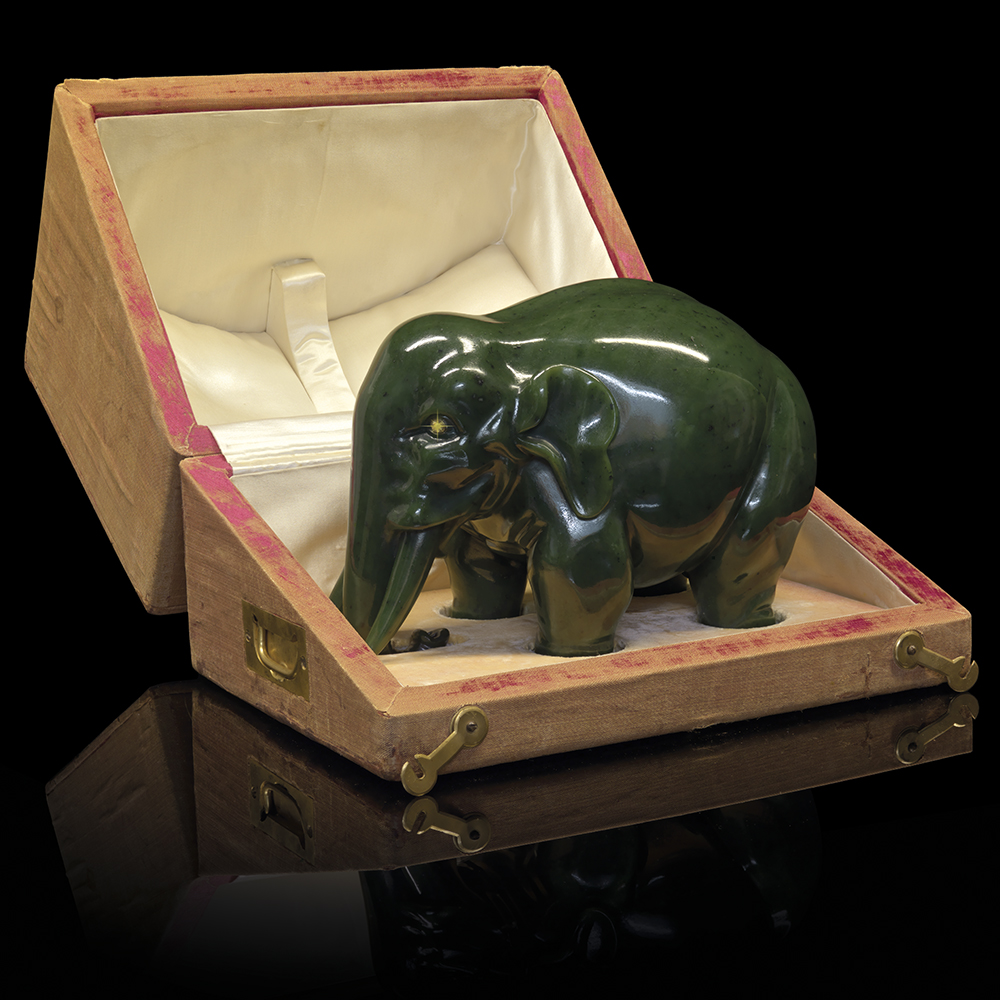26 November 2014 Russian Art Auctions
26 November 2014

368. A FABERGÉ RARE LARGE CARVED NEPHRITE MODEL OF AN ELEPHANT
CIRCA 1900, APPARENTLY UNMARKED
Height 20 cm, length 26 cm, weight 11kg.
250,000–350,000 GBP
Provenance: Private Collection, Connecticut.
Christie’s New York, Russian Art, 18 April 2008, lot 303.
Realistically modelled in a standing position with tail and trunk curled under, with rose-cut diamond-set eyes, held in original red velvet and silk lined presentation box.
Fabergé owes his fame to the remarkable craftsmanship and the unique, unrivalled inventiveness of his designs. The firm’s name also
goes hand in hand with the splendour, glory and eventual tragic demise of the Russian Imperial family and their court. Fabergé’s extravagant, elaborate commissions influenced general trends and the
fashion of the period but also brought world-wide acclaim. From
European royalty to Oriental monarchs, Fabergé’s objects of fantasy
were highly sought after. Indeed, his extensive travels, fascination
with nature and study of Oriental art are expressed throughout his
many oeuvres. Most importantly, such influences can be found in his
many hardstone carved objects, be it a series of animals or the exquisite flower studies which have truly become hallmarks of the Fabergé style. Like many of his carved figures, the elephant combines extraordinary craftsmanship with expensive and elegant materials, however it is its grand scale which distinguishes the offered lot from similar works. Largely influenced by netsuke representations of animals, Fabergé is particularly famous for reproducing a lively menagerie of characterful and charming figures.
Royal patronage of Fabergé’s productions also suggest that the extensive travels of the young Tsarevich between 1890–1891 in the Far East played an influential role in shaping the fashion for Oriental
inspired art. This fascination gave rise to a new social tradition — that
of gifting carved objects as symbols of good luck, prosperity, longevity and abundance — a custom which was eagerly adopted by the
Russian Imperial court.
However, among numerous exquisitely carved examples, the present
unusually large carved elephant immediately stands out, not least because of its size. Having been appointed not only as court jeweller
to the Romanovs but also as royal goldsmith to the Siamese court
of King Rama V, Fabergé effectively combined Western and Eastern
styles. This union of traditional symbols, fantasy and magnificence
are exquisitely portrayed in the present piece.
The elephant was a very popular Oriental symbol not only in Siam,
but also in India and China where Fabergé regularly travelled to.
Although it is difficult to establish a direct link, it is nonetheless intriguing to know that there were twenty-one nephrite elephants in
a Siamese royal temple which were made by the Russian jeweller
to the order of King Rama VI (for more information, see Scheverell
Sitwell, Great Temples of the East, Ivan Obolensky Inc, 1962, p.35).
Carved from a single block of nephrite, such large scale models by
Fabergé are very rare. Another example of a similarly sized elephant
carved in bowenite, was sold by Christie’s at Geneva, 17 th May, 1994
(lot 232). Nevertheless, perhaps the most obvious comparison would
be with the several hardstone elephant figures in the British Royal
Collection. Despite the similarity between the carving technique and
form, the size and grandeur of this particular figure make it truly
notable.
Notes on symbols:
* Indicates 5% Import Duty Charge applies.
Ω Indicates 20% Import Duty Charge applies.
§ Indicates Artist's Resale Right applies.
† Indicates Standard VAT scheme applies, and the rate of 20% VAT will be charged on both hammer price and premium.